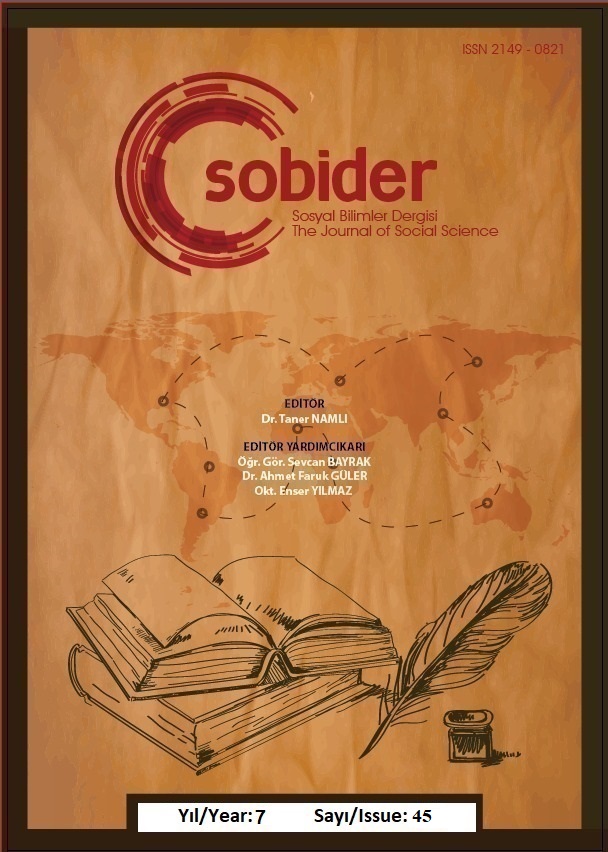Author :
Abstract
Heykel, iki boyutlu yüzeyde üç boyut etkisi yaratan resim, desen, fotoğraftan farklıdır. Algılama kapasitemize yönelerek, yanılsamadan uzak ve gerçekten üç boyutlu şekilde varlığını sürdürür. Geçmişteki heykellerin çoğu, kütlenin düzenlenmesine öncelik vererek, onu vurgulayacak şekilde biçimlendirilmiştir. Boşluklar, kütlenin varlığına katkı sağlayan ikincil öğedir. Modernizm ile birlikte, 20. yüzyılın ilk yarısında boşluk, heykel formunun bir öğesi kabul edilir. Heykel hacimlerinin içine girerek iç elemanlarını açığa çıkaran ve üç boyutlu formlarda boşluğun önemini ilk fark edenler kübist sanatçılardır. Bu, boşluğun kütle gibi somut şekilde ele alındığı, hatta önüne geçtiği sürecin başlangıcıdır. Makalede boşluk kavramı, üç boyut ve hacimle ilgili en doğrudan deneyimi sağlayan heykelin temel bileşenleri açısından, sanat eserleri üzerinden değerlendirilecektir.
Keywords
Abstract
Sculpture is different from painting, drawing and photography, which creates a three-dimensional effect on the two-dimensional surface. By turning to our perception capacity, it exists in a truly three-dimensional way, far from illusion. Most of the sculptures in the past are shaped to highlight it, giving priority to the arrangement of the mass. Void are secondary elements that contribute to the presence of mass. Along with modernism, in the first half of the 20th century, void is considered an element of the sculptural form. Cubist artists are the first to realize the importance of the void in three-dimensional forms by revealing the interior elements by entering into the sculpture volumes. This is the beginning of the process where the void is handled and even preceded by mass, like mass. In the article, the concept of void will be evaluated from the works of art in terms of the basic components of the sculpture, which provides the most direct experience about three dimensions and volume.
Keywords
- Antmen, Ahu (2019). 20.Yüzyılda Batı Sanatında Akımlar,10. Baskı, İstanbul: Sel Yayıncılık
- Antmen, Ahu (2019). 20.Yüzyılda Batı Sanatında Akımlar,10. Baskı, İstanbul: Sel Yayıncılık Dempsey, Amy (2019). Modern Sanat, Çev: Deniz Öztok, İstanbul: Hep Kitap
- Genç, Adem (1983). Dada, Doktora Tezi, İzmir: Dokuz Eylül Üniversitesi, Resim Bölümü Huntürk, Özi (2016). Heykel Ve Sanat Kuramları. İstanbul: Hayalperest Yayınevi.
- İpşiroğlu, Nazan-Mazhar (1983). Oluşum Süreci İçinde Sanatın Tarihi. İstanbul: Cem Yayınevi İpşiroğlu, Nazan-Mazhar (1993). Sanatta Devrim. İstanbul: Remzi Kitabevi
- Lynton, Norbert (1991). Modern Sanatın Öyküsü. Çev. Cevat Çapan, Şadi Öziş, İstanbul: Remzi Kitabevi
- Öndin, Nilüfer (2019). Modern Sanat. İstanbul: Hayalperest Yayınevi
- Read, Herbert (1951). Aspects Of Form. Bloomington: Indiana University Press Rogers, L. R ( 1969). Sculpture. Londra: Oxford Yayınları
- Şenyapılı, Önder (2003). Otuz Bin Yıl Öncesinden Günümüze Heykel. Ankara: ODTÜ Geliştirme V. Yay.
- Yılmaz, Mehmet (2013). Modernden Postmoderne Sanat. Ankara: Ütopya Yayınları https://sozluk.gov.tr/, Erişim:18-01-2020
- Resim.1- Rogers, L. R (1969). Sculpture. Sayfa: 26, Londra: Oxford YayınlarıResim.2- Rogers, L. R (1969). Sculpture. Sayfa: 30, Londra: Oxford Yayınları Resim.3- Picasso, “Head Of Woman”, 1909. Erişim: 17-02-2020
- Resim.4- Constantin Brancusi, Bird in Space, 1928, (137.2 x 21.6 x 16.5) cm., bronz. Erişim: 17-02-2020
- Resim.5/6- Alexander Archipenko, "Mujer andando", 1912. Erişim: 17-02-2020
- https://www.christies.com/lotfinder/Lot/alexander-archipenko-1887-1964-walking-5971056- details.aspx
- Resim.7- Ossip Zadkine, Yıkılmış Şehir, 1951-1953, bronz. Erişim: 17-02-2020http://artincambridge.blogspot.com/2013/02/talos-is-this-ugliest-statue-in.html
- Resim.8- Ossip Zadkine, Yıkılmış Şehir, 1951-1953, bronz. Erişim: 17-02-2020 https://gedenk-cultuur.nl/directory/item/verwoeste-stad-ossip-zadkine
- Resim.9- Henry Moore, Uzanan Figür, 1938, ahşap. Erişim: 19-02-2020
- https://www.tate.org.uk/art/artists/henry-moore-om-ch-1659/henry-moores-sculpturesResim.10- Barbara Hepworth, Wave, 1943-44, ahşap, boya, tel. Erişim: 19-02-2020https://www.nationalgalleries.org/art-and-artists/57366/wave
- Resim.11- Julio Gonzalez,1939, Cactus Man I, Demir, 70 cm. Erişim: 19-02-2020 https://en.wikipedia.org/wiki/File:Cactus_Man_-_Gonz%C3%A1lez.jpg
- Resim.12- Alberto Giacometti, Boşluğu Tutan Eller, 1934, bronz döküm (1954). Erişim: 19-02- http://arkeopolis.com/alberto-giacometti-ile-heykel-sanatina-bir-bakis/
- Resim.13- Alberto Giacometti, Boşluğu Tutan Eller, Detay. Erişim: 19-02-2020
- Resim.14- Umberto Boccioni, Uzaydaki Devamlılığın Benzersiz Formları / Unique Forms of Continuity in Space, 1913. Erişim: 20-02-2020
- Resim.15- Vladimir Tatlin, Kontr-rölyef, 0.10 Sergisi, 1915. Erişim: 20-02-2020
- https://www.e-skop.com/skopbulten/rus-avangardi-formlarin-siyaseti-ve-tatlin-kulesi/2748 Resim.16- Antoine Pevsner, Head, 1923/24. Erişim: 17-02-2020
- Resim.17- Naum Gabo, Linear Construction in Space No. 2. Erişim: 20-02-2020 https://www.flickr.com/photos/66124712@N07/6390130211





